Unveiling Patterns with Association Rule Mining (ARM)
Association Rule Mining (ARM) is a powerful data mining technique designed to uncover hidden patterns, relationships,
and dependencies within large datasets. By analyzing co-occurrences of items, ARM allows businesses and researchers
to extract meaningful insights that can influence strategic decision-making.
It is widely utilized in various fields, including:
- Market Basket Analysis: Identifying items frequently bought together in retail stores.
- Recommendation Systems: Powering personalized product and content suggestions (e.g., Amazon, Netflix).
- Fraud Detection: Recognizing unusual transaction patterns in banking and cybersecurity.
- Medical Diagnostics: Finding correlations between symptoms, diseases, and treatments.
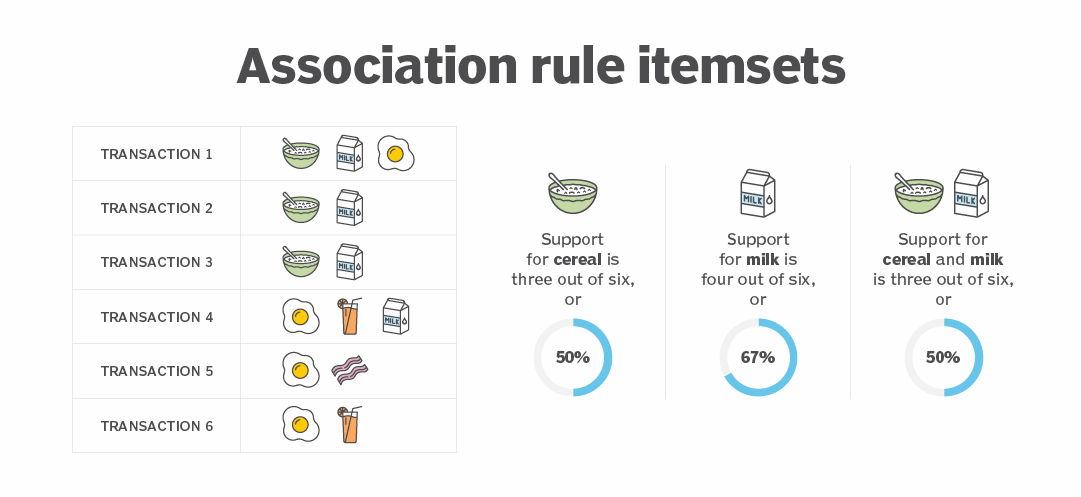
Core Components of ARM
ARM operates using three fundamental statistical metrics, each playing a crucial role in determining the strength and validity of associations:
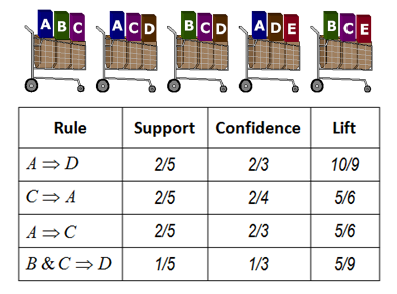
- Support: Measures how frequently an itemset appears in the dataset. Higher support indicates greater relevance.
- Confidence: Represents the probability that item B is purchased when item A is bought, serving as a measure of rule reliability.
- Lift: Evaluates the strength of the association by comparing the co-occurrence of items to what would be expected by chance. A lift value greater than 1 indicates a strong positive correlation.
Mathematical Formulation
The following formulas define the key measures used in ARM:
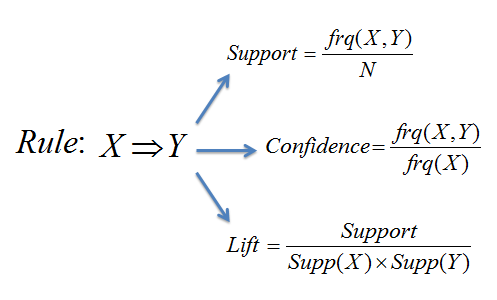
Understanding Association Rules
Association rules define relationships between items in a dataset using the general form:
A → B (If A is purchased, then B is likely to be purchased)
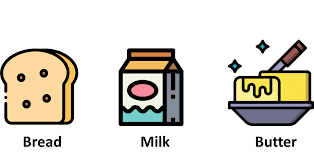
Example:
Consider a supermarket scenario where the system detects the following pattern:
Customers who purchase milk and bread frequently buy butter as well.
This results in the association rule:
{Milk, Bread} → {Butter}
The Apriori Algorithm: Mining Strong Rules
The Apriori Algorithm is one of the most widely used techniques for mining association rules. It efficiently discovers frequent itemsets and derives strong rules using support, confidence, and lift measures.
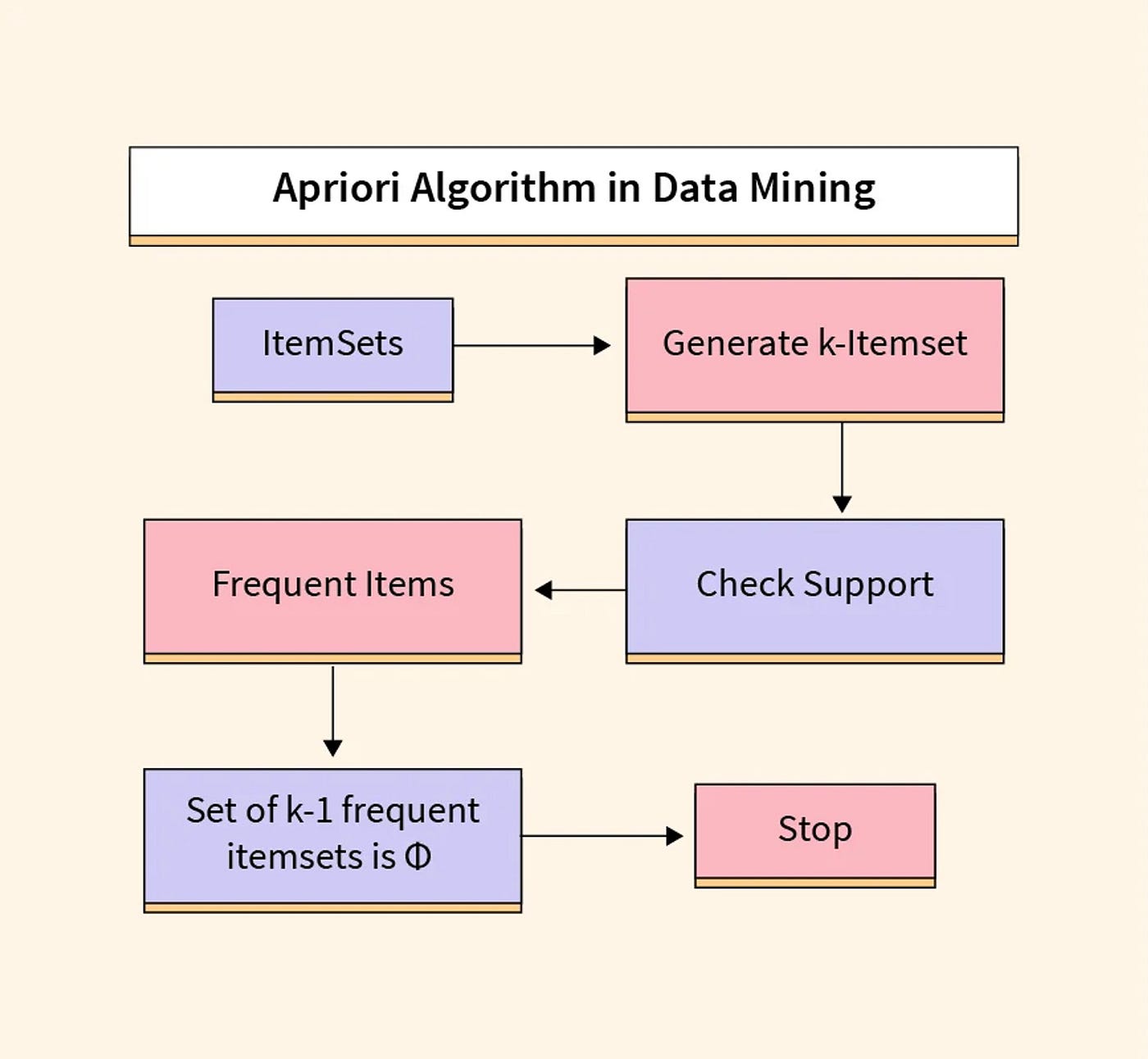
Step-by-Step Breakdown of Apriori
The Apriori algorithm follows an iterative process to extract meaningful rules:
- Step 1: Scan the dataset and calculate support for each individual item.
- Step 2: Remove items that do not meet the minimum support threshold, eliminating infrequent patterns.
- Step 3: Generate larger itemsets by combining frequent items and filter them based on the support threshold.
- Step 4: Extract association rules from the frequent itemsets and evaluate their confidence and lift values.
Why is Apriori So Effective?
The Apriori algorithm is widely preferred for pattern recognition and association discovery due to its efficiency and scalability. Key advantages include:
- Scalability: Can process large datasets efficiently by pruning irrelevant itemsets early.
- Real-World Applications: Used in retail, finance, healthcare, cybersecurity, and bioinformatics to detect behavioral patterns and anomalies.
- Enhanced Decision-Making: Helps businesses optimize product placement, inventory management, marketing campaigns, and targeted recommendations.
Data Preparation for Association Rule Mining
Association Rule Mining (ARM) requires data in a transactional format, where each row represents a set of items that frequently appear together. Unlike supervised learning models, ARM does not rely on labeled data. Instead, it uncovers patterns and relationships based on item co-occurrences.
Raw Data Overview
The raw dataset consists of food items with attributes such as description, category, calories, protein, fat, and carbohydrates. However, this raw format is not directly usable for ARM since it contains numerical values and metadata that do not conform to a transaction-based structure.

Data Processing Steps
To transform the raw dataset into a format suitable for ARM, we followed these structured steps:
- Selected Relevant Columns: Removed unnecessary attributes such as brand names and retained only meaningful nutritional and categorical data.
- Handled Missing Values: Filled missing values in numeric attributes with 0 and categorical attributes with "Unknown" to prevent data loss.
- Converted Numeric Values into Categories: Transformed calories, protein, fat, and carbohydrate values into labeled categories (e.g., "High-Fat", "Low-Carbs").
- Formatted Data as Transactions: Removed the description column and combined the categorical attributes into a single transaction row, ensuring compatibility with ARM models.
- Eliminated Duplicates: Removed redundant transactions to improve the accuracy of generated rules.
- Saved Preprocessed Data: The cleaned dataset was stored as arm_prepared_data.csv.
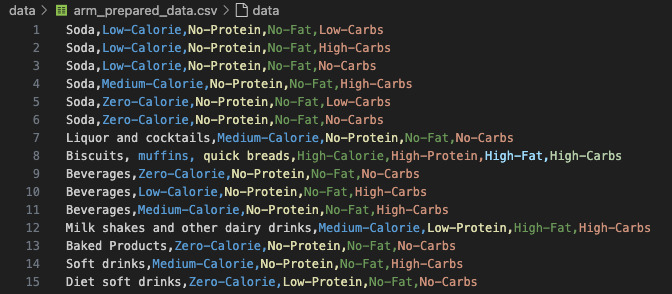
Association Rule Mining Analysis
After preparing the dataset, we applied Association Rule Mining (ARM) using the Apriori Algorithm to uncover meaningful relationships between food items.
Applying the Apriori Algorithm
The Apriori Algorithm was implemented with the following parameters:
- Support Threshold: 1% (Items appearing in at least 1% of transactions are considered frequent).
- Confidence Threshold: 50% (Rules are generated only if they hold true at least 50% of the time).
- Minimum Rule Length: 2 (Each rule must contain at least two items).
Extracting Insights
We computed and sorted the top 15 association rules based on three fundamental metrics:
- Support: Measures how frequently an itemset appears in transactions.
- Confidence: Indicates how often the rule is correct.
- Lift: Evaluates the strength of the rule by comparing it to random chance.
Generated Association Rules
The following visualizations highlight the most significant association rules based on Support, Confidence, and Lift. These metrics help uncover hidden patterns in food consumption behaviors, enabling strategic recommendations for dietary analysis and menu planning.
Top 15 Rules by Support

Support measures how frequently an itemset appears in the dataset. Higher support values indicate food items that are consistently associated with one another.
- The most frequently occurring rule is {High-Calorie} → {High-Carbs}, which suggests that foods categorized as high-calorie are strongly linked with high-carbohydrate content.
- Similarly, High-Fat and High-Protein are frequently associated, indicating a pattern in protein-rich and fatty food consumption.
- The high support values of these rules suggest a dominant trend in nutrient compositions, reinforcing common dietary patterns.
Top 15 Rules by Confidence

Confidence measures the likelihood that item B is purchased when item A is purchased. A higher confidence value means a strong predictive relationship between food items.
- Rules like {Fruit & Vegetable Juice} → {Nectars & Fruit Drinks} and {Salts} → {Seasoning Mixes} have a confidence value of nearly 1.0 (100%), meaning these items are almost always consumed together.
- The strong confidence in Salts and Marinades & Tenderizers suggests that these food categories are heavily interconnected in dietary patterns.
- Higher confidence values indicate dependable relationships, useful for meal planning and food pairings in restaurants or diet recommendations.
Top 15 Rules by Lift
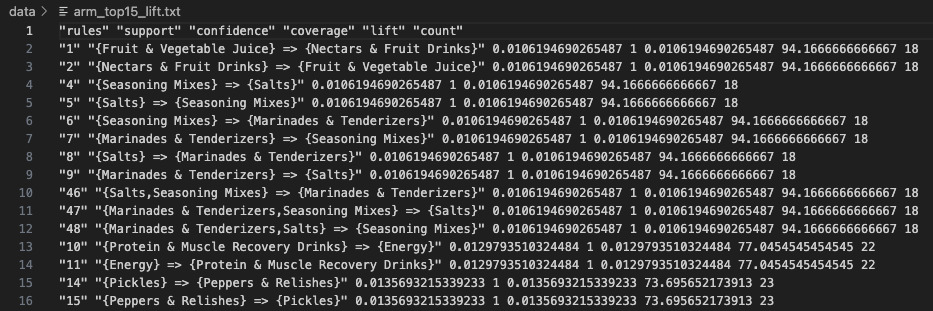
Lift determines how much more likely items are bought together compared to random chance. A lift value greater than 1 indicates a strong positive association.
- The rule {Salts} → {Seasoning Mixes} has an exceptionally high lift value (~94), suggesting that these items are highly dependent on each other.
- Rules involving Peppers & Relishes, Olives, and Pickles have high lift values, meaning these items have strong interdependencies in food consumption.
- Lift values above 70 indicate highly correlated items, making them prime candidates for strategic menu recommendations or grocery bundling.
Conclusion
These association rules provide valuable insights into the relationships between food items based on their nutritional profiles and consumption patterns. The high-confidence and high-lift rules suggest strong dependencies, useful for:
- Menu Recommendations: Optimizing restaurant menus by suggesting highly associated food items.
- Dietary Analysis: Understanding common nutritional groupings for better meal planning.
- Consumer Behavior Predictions: Forecasting food consumption trends for marketing strategies in the food industry.
Top 15 Frequent Items in Transactions
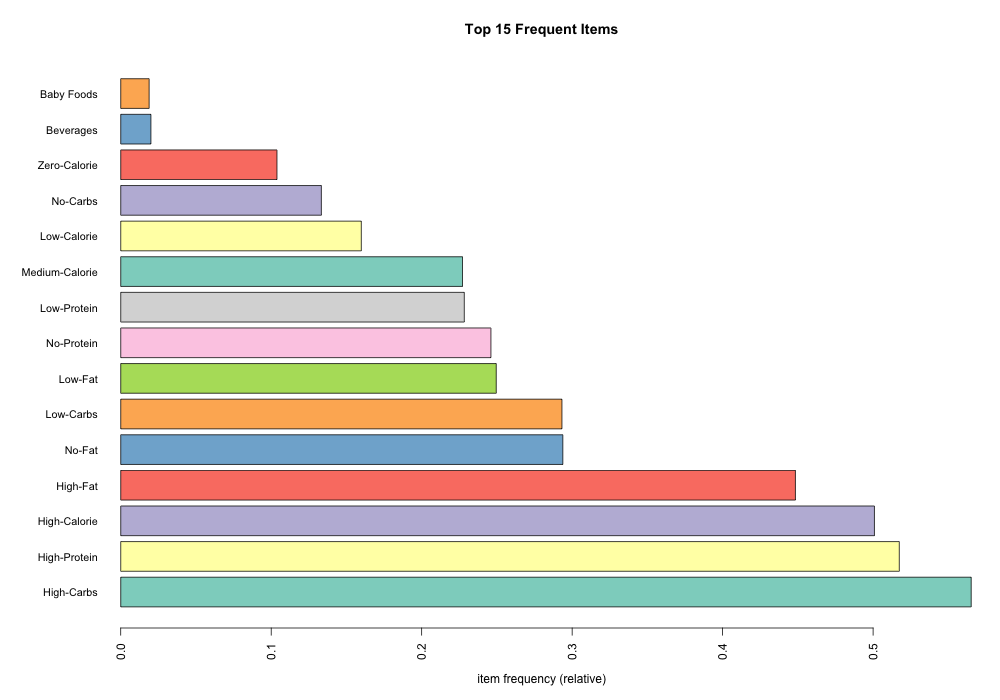
The item frequency plot presents the top 15 most frequently occurring items in the dataset. It highlights dominant food attributes such as High-Carbs, High-Protein, High-Fat, and No-Fat, which appear frequently in transactions. This suggests that dietary habits are diverse, with distinct patterns in macronutrient consumption. Identifying frequent items helps in understanding the clustering of food attributes and their potential applications in dietary analysis and recommendation systems.
Support vs Confidence Scatter Plot (Shaded by Lift)
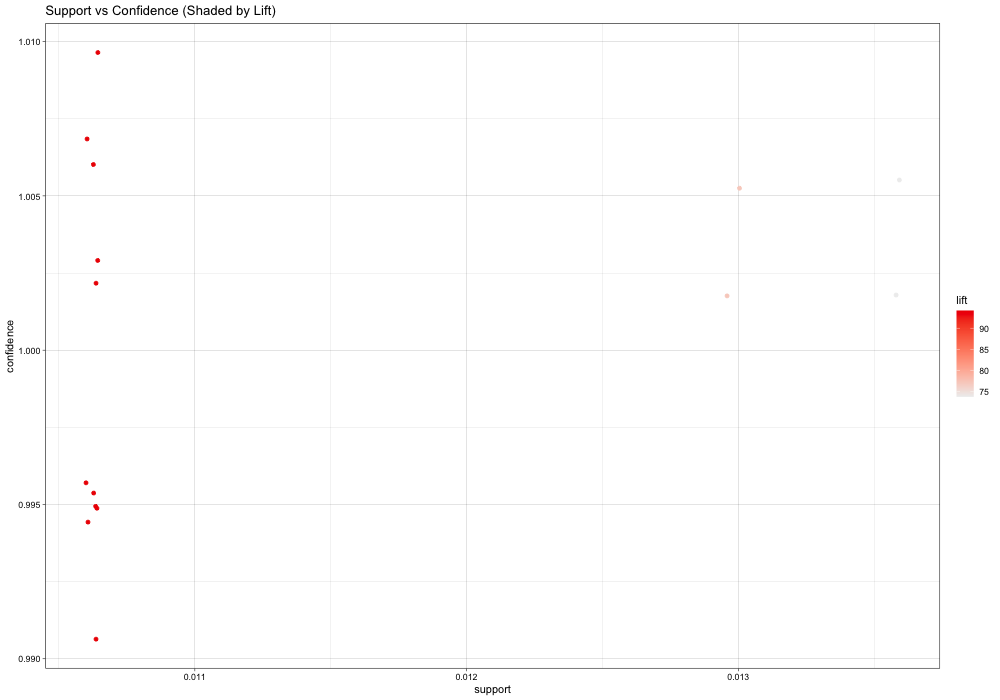
This scatter plot visualizes the relationship between support and confidence across association rules. The shading intensity corresponds to the lift value, where darker shades indicate stronger item associations. The plot helps in filtering out rules that have both high support and high confidence, which are more actionable for insights into consumer behavior and food pairings.
Association Rule Network Visualization
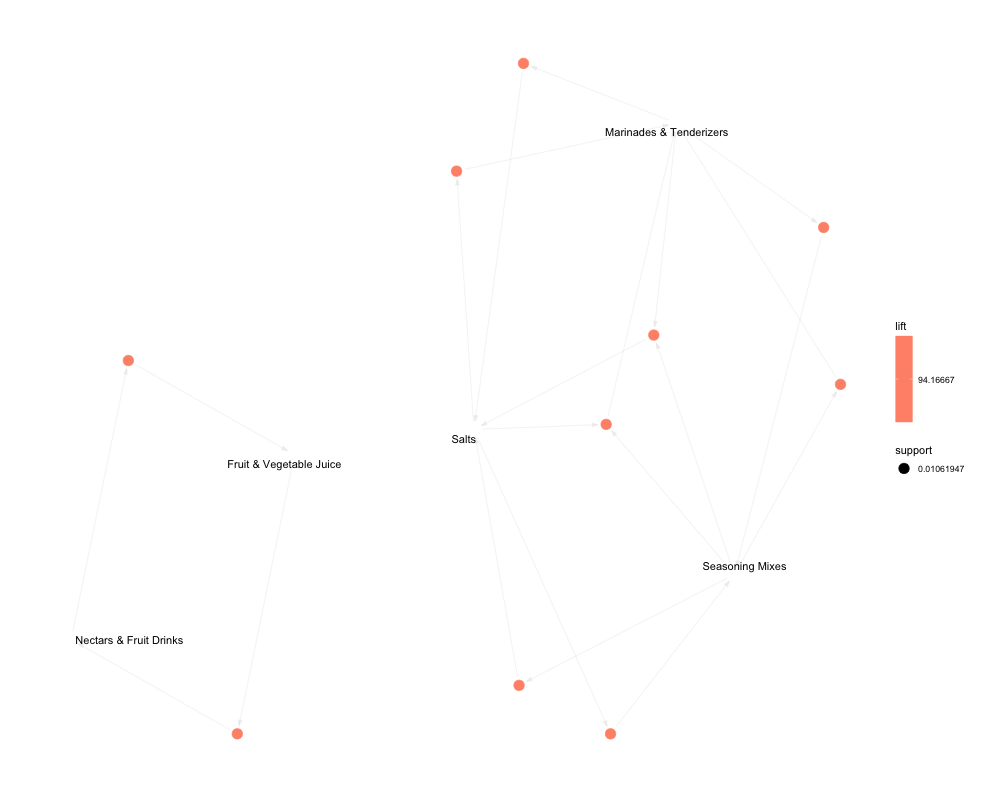
This network graph illustrates the top 10 association rules, with nodes representing food items and edges denoting strong co-occurrences. Notably, clusters around Seasoning Mixes, Marinades & Tenderizers, and Salts indicate strong associative patterns. This suggests that these items frequently appear together in recipes or purchasing behaviors. The visualization aids in detecting product bundling opportunities and consumer preferences.
Matrix Plot: Item Associations
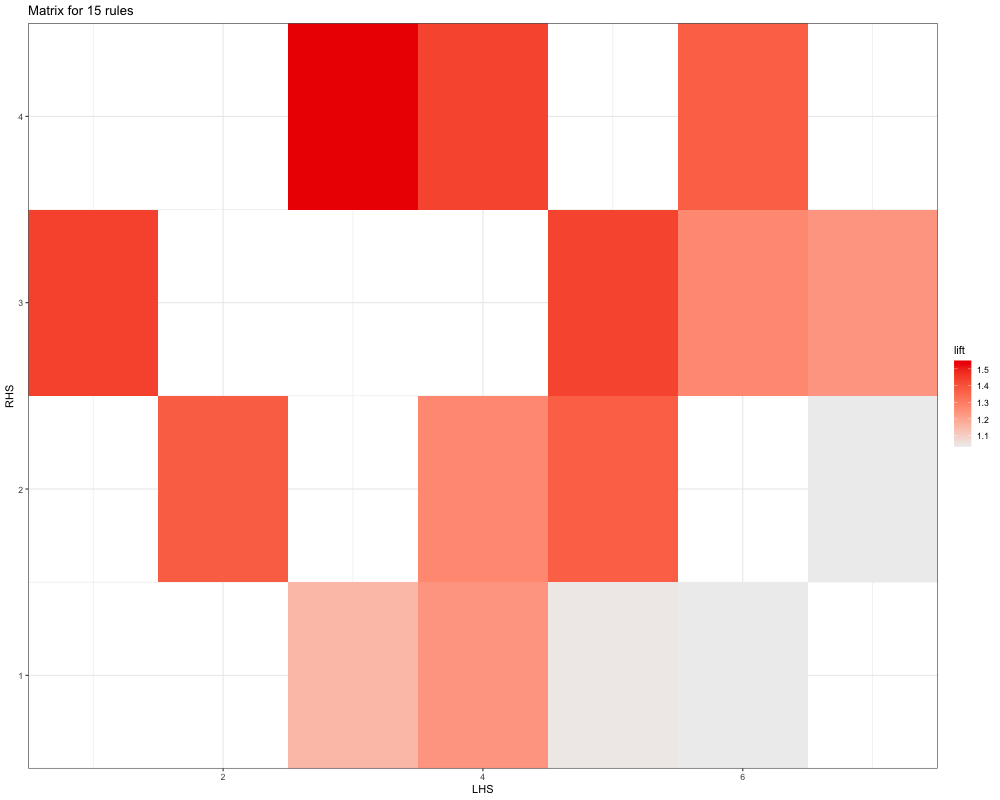
The matrix plot provides a structured visualization of item associations, with color intensity representing the strength of relationships. Darker shades indicate stronger associations between items, allowing us to quickly pinpoint the most relevant food groupings. This type of visualization is particularly useful in analyzing how different items are frequently purchased together, leading to actionable insights for retailers and dietary planners.
Grouped Matrix of Top Association Rules

The grouped matrix plot categorizes rules based on antecedents (LHS) and consequents (RHS). It allows for an intuitive understanding of item relationships by grouping frequently occurring pairs. Items appearing in close proximity are more likely to be purchased together, making it easier to detect meaningful associations in food consumption trends.
Top 15 Rules by Support
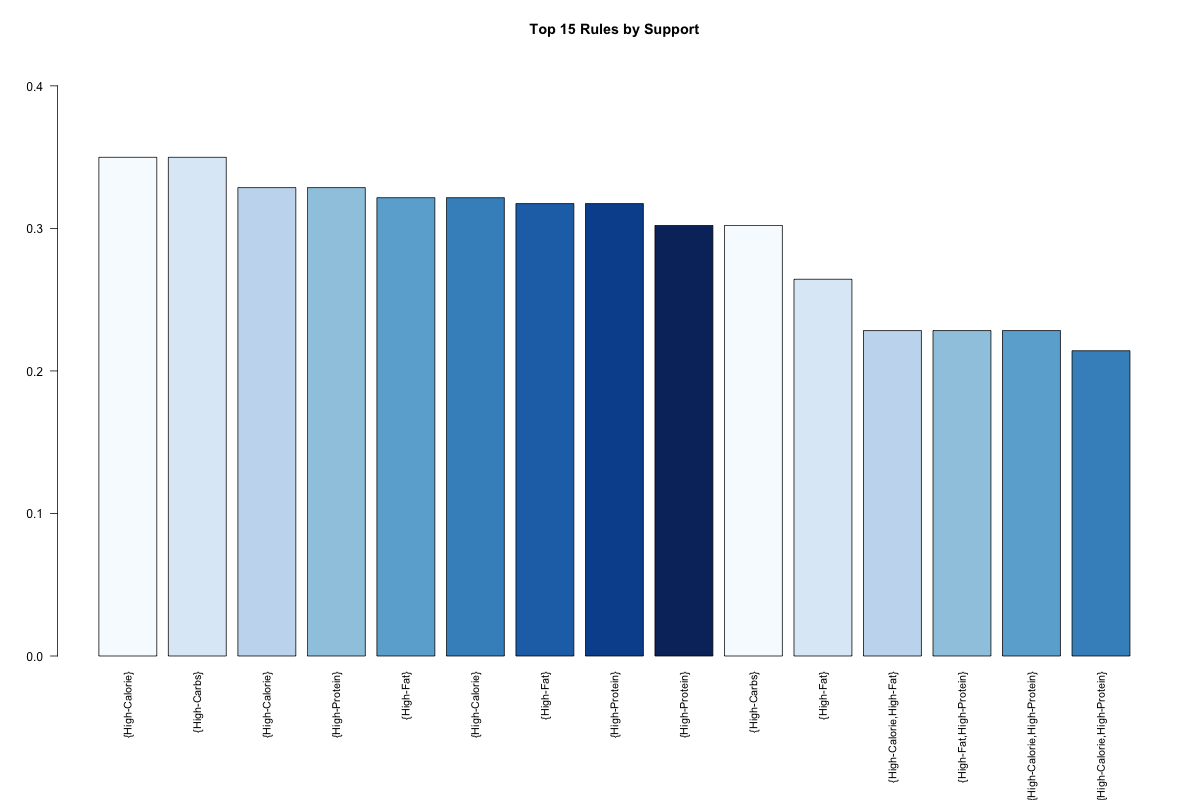
Support quantifies how frequently an itemset appears in the dataset. The bar chart reveals that combinations such as High-Calorie → High-Carbs and High-Fat → High-Protein are among the most commonly occurring. These high-support rules suggest patterns that are critical in understanding consumer choices, aiding in targeted product placements and personalized diet recommendations.
Top 15 Rules by Confidence
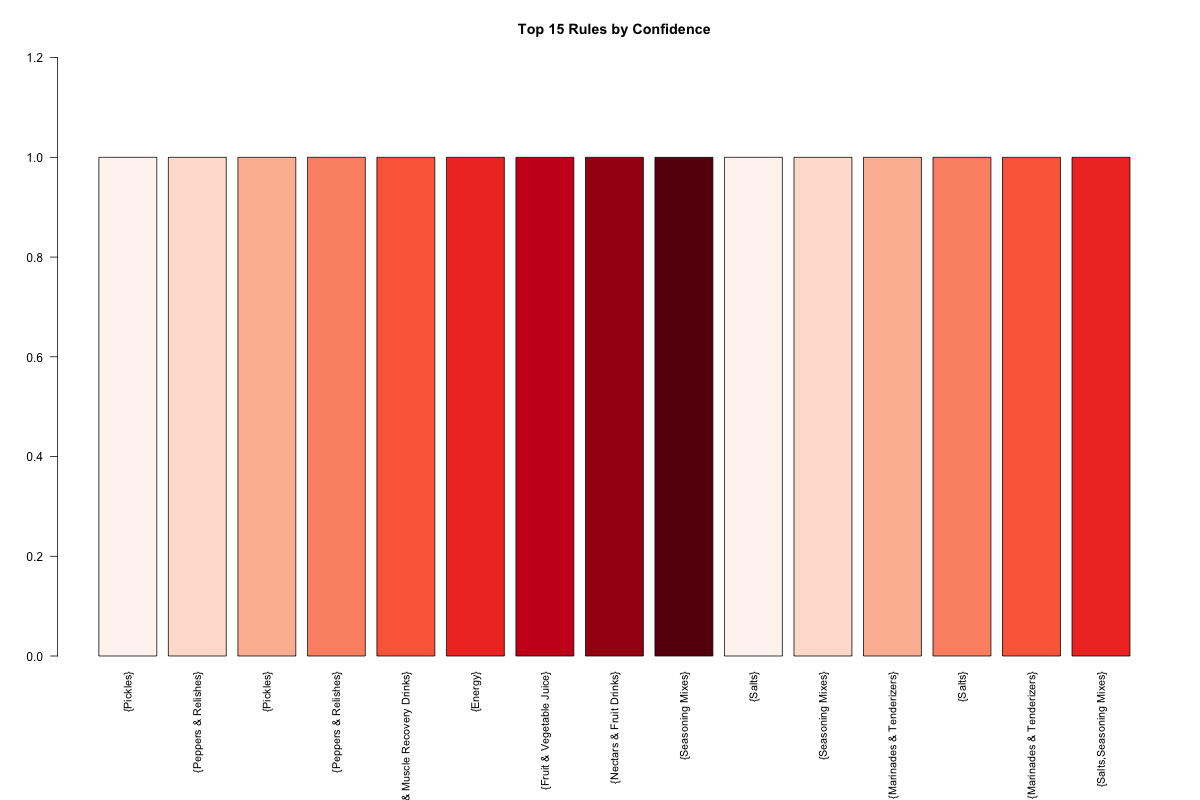
Confidence measures the likelihood that an item is purchased given the presence of another. The visualization highlights rules with a confidence close to 1.0, indicating near-certain co-purchases. For instance, Seasoning Mixes → Salts has a high confidence score, suggesting a strong conditional dependency between these two items, valuable for targeted promotions and pricing strategies.
Top 15 Rules by Lift
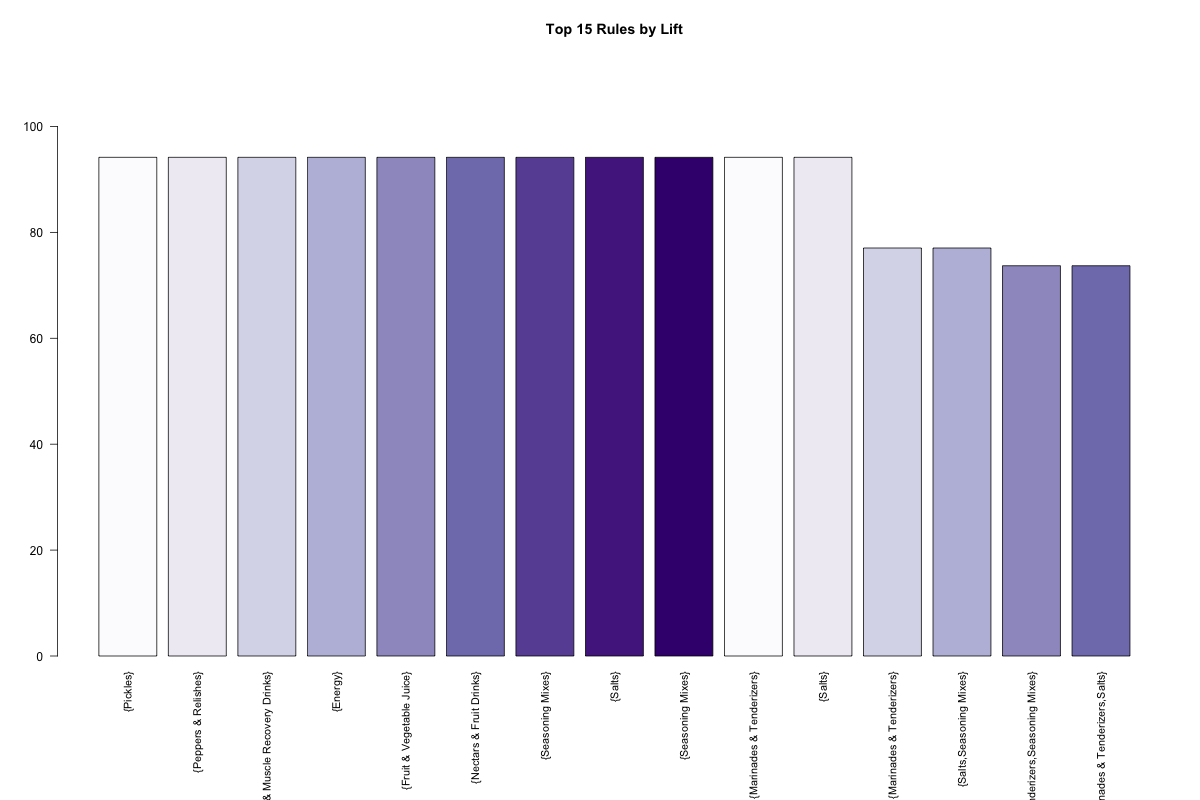
Lift evaluates how much more likely items are bought together compared to random chance. A lift greater than 1 indicates a strong positive relationship. The highest lift values are observed in rules involving Seasoning Mixes, Salts, and Marinades & Tenderizers, emphasizing their strong interdependence. These findings are crucial for product placement strategies and designing promotional offers.
Conclusions
The findings from the Association Rule Mining (ARM) analysis provide valuable insights into food consumption patterns, nutrient associations, and purchasing behaviors. By identifying frequently occurring item relationships, this study enables better dietary recommendations, strategic food pairings, and consumer behavior analysis.
Key Findings
- High-Carbohydrate and High-Calorie Foods Are Strongly Linked: The most frequent rules indicate that high-calorie foods are commonly associated with high-carbohydrate content. This trend suggests that consumers often choose energy-dense food combinations, which is crucial for dietary monitoring and nutritional guidance.
- High-Protein and High-Fat Foods Often Co-Exist: A strong correlation was found between high-protein and high-fat food items. This insight is valuable for meal planning and food processing industries, where understanding these relationships can help design balanced dietary options.
- Seasoning Mixes, Salts, and Marinades Have Strong Associations: The network visualization highlights that seasoning mixes, salts, and marinades & tenderizers frequently appear together. This finding suggests that these items are commonly used together in food preparation, making them ideal for grocery bundling and personalized product recommendations.
- Lift Values Confirm Strong Non-Random Food Associations: High lift values indicate that many food items are consistently consumed together at much higher rates than random chance. This confirms that consumer choices follow structured dietary patterns, which businesses can leverage for strategic product placement and marketing strategies.
- Predictive Insights for Personalized Recommendations: Rules with high confidence values (close to 100%) indicate that when certain food items are selected, others are almost always included. This insight is highly relevant for AI-driven personalized meal planning, smart grocery recommendations, and targeted nutrition strategies.
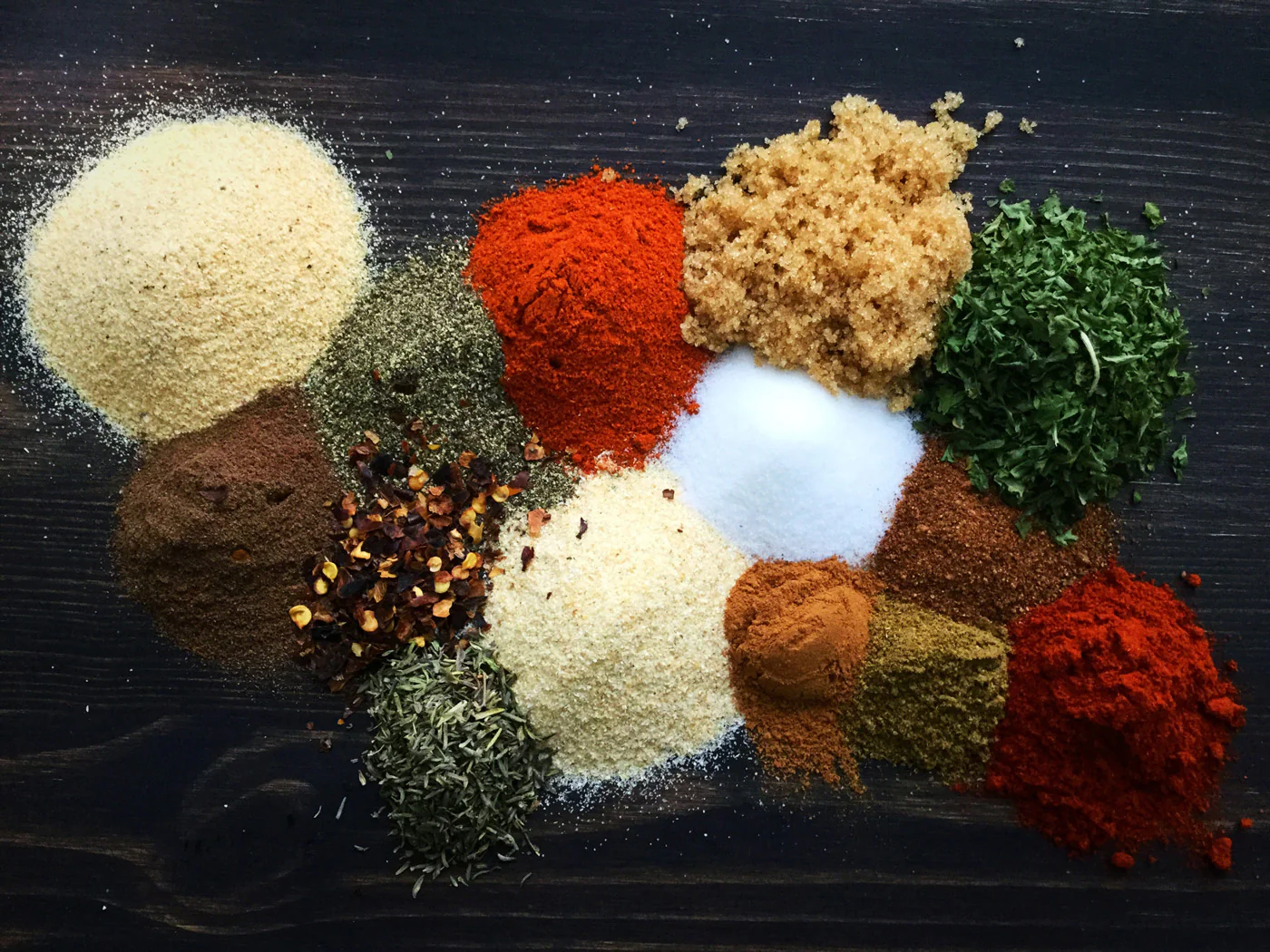
Relevance to Our Topic
These insights play a critical role in understanding dietary behaviors, nutrition trends, and purchasing habits. The identified associations between food attributes can be applied in various areas, including:
- Dietary Planning: Helping individuals and dietitians optimize food choices based on nutrient pairings.
- Consumer Behavior Predictions: Understanding purchasing patterns to enhance grocery store arrangements and restaurant menus.
- Health and Nutrition Applications: Identifying unhealthy food combinations for targeted dietary interventions.
- Retail and Marketing Strategies: Using high-lift associations for bundled product promotions and cross-selling in food retail.
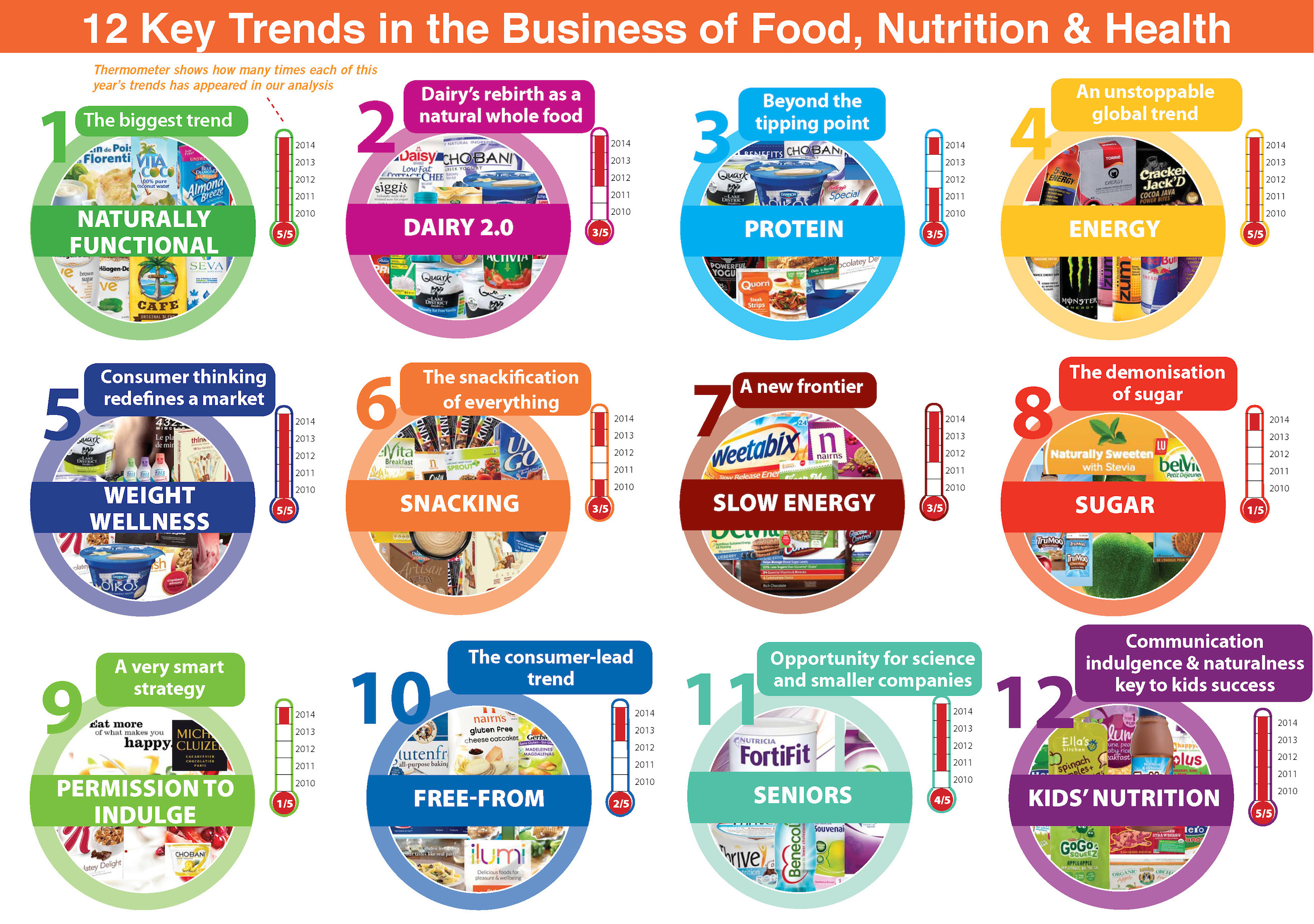
Final Thoughts
The application of Association Rule Mining has revealed valuable insights into food consumption behaviors, enabling better product recommendations, targeted marketing, and personalized nutrition plans. The high-confidence and high-lift rules suggest strong dependencies, which can be used for strategic decision-making in food and retail industries. Future studies could enhance these insights by incorporating real-time food consumption data, price sensitivity analysis, and dietary restrictions for even more precise recommendations.